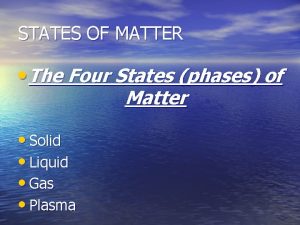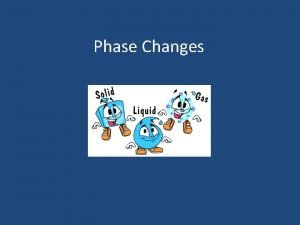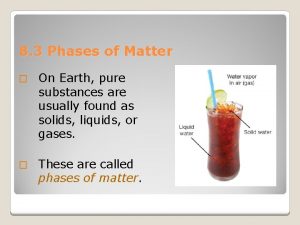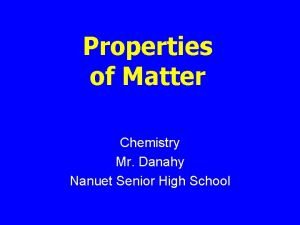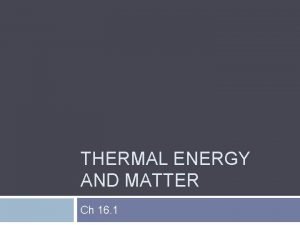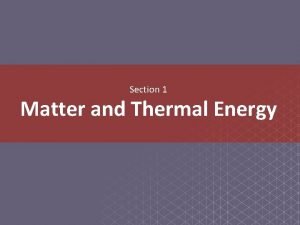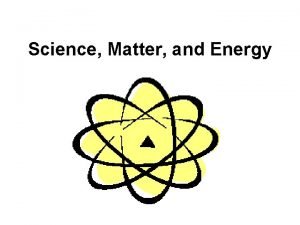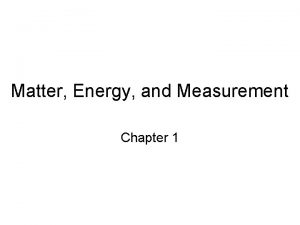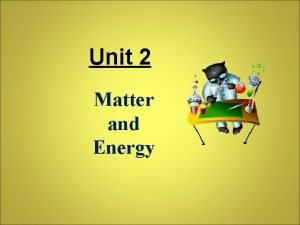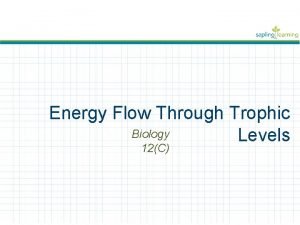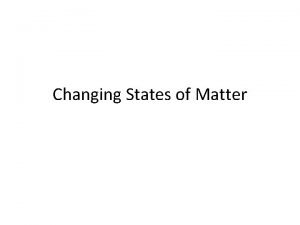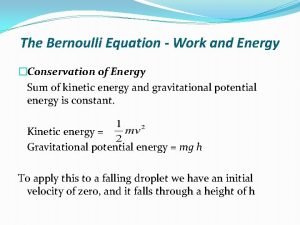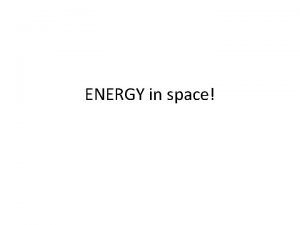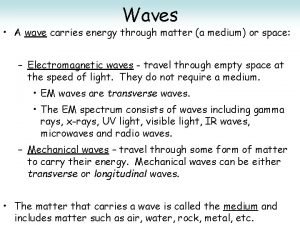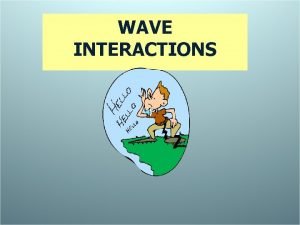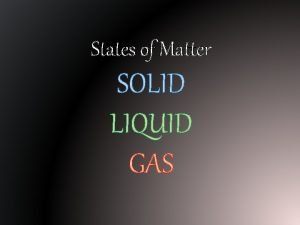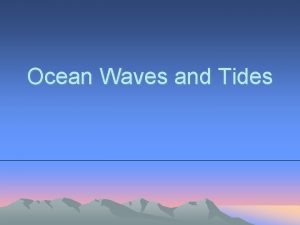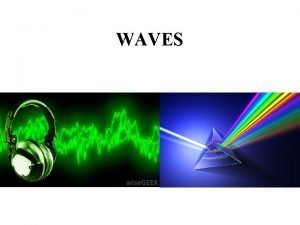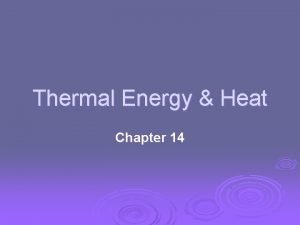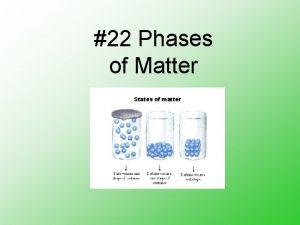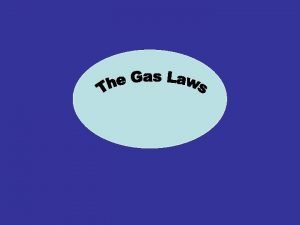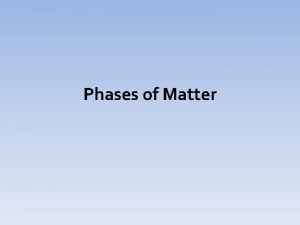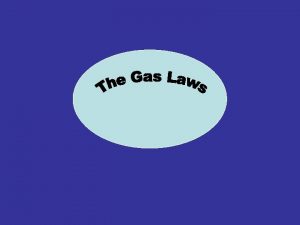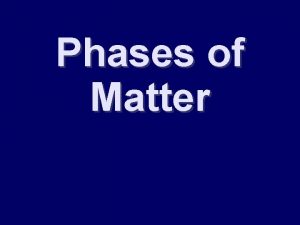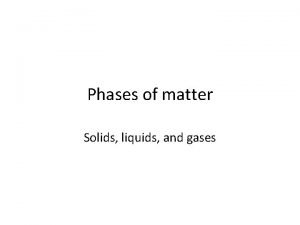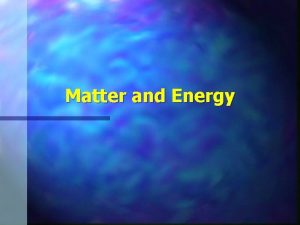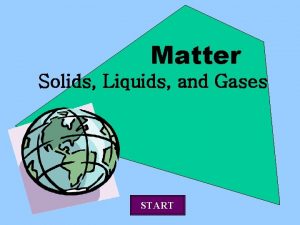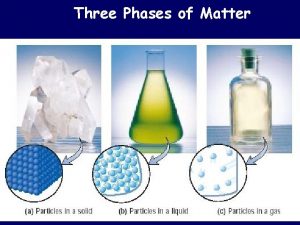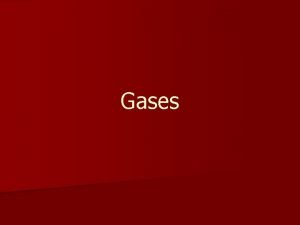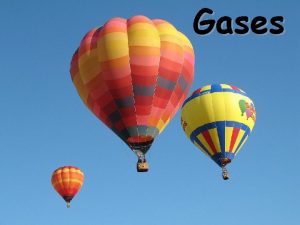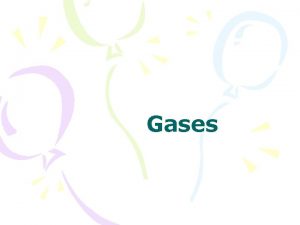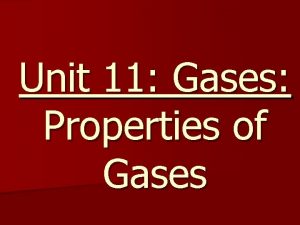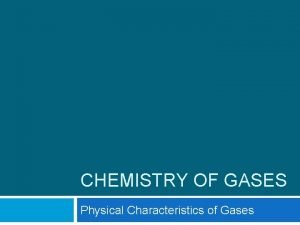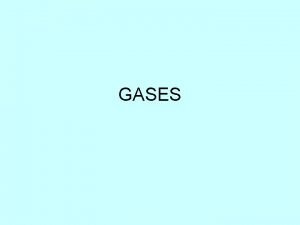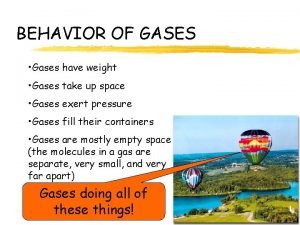Phases of Matter Energy Gases and Solutions FINAL










































- Slides: 42

Phases of Matter, Energy, Gases, and Solutions FINAL EXAM REVIEW

DO NOW �Pick up the exam review. �You have seven days to get your make-up work in. �You have three days (including today) to get your $1, 100% cotton t-shirt, and bag to class. �If you have a pink test Redo slip, today is the deadline to get it turned in so you can take the test by May 15.

REVIEW FOR FINAL PHASES AND ENERGY � Explain the behavior of solids, liquids, and gases in terms of the kinetic theory. � Differentiate between the three phases of matter. � Discuss a heating curve as a substance is taken from a solid to the vapor state. � Discuss a phase diagram and understand the significance of the terms associated with it (Tm, Tb, etc. ). � Explain a phase change and interpret these changes based on graphs. � Determine the relationship between energy and change of state. � Be able to perform calculation for heat of fusion, heat of vaporization and heat changes.

REVIEW FOR FINAL PHASES AND ENERGY �Explain the behavior of solids, liquids, and gases in terms of the kinetic theory. 1. 2. 3. All matter is composed of small particles. The small particles are in constant, random motion. All particles have perfectly elastic collisions – there is no change in total kinetic energy (KE).

REVIEW FOR FINAL PHASES AND ENERGY �Differentiate between the three phases of matter. Volume Shape Spacing IMFs SOLID Definite Vibrate along a fixed point Stronger LIQUID Definite No Definite Slid past each other Strong GAS No Definite Behave independently of each other Very Weak

REVIEW FOR FINAL PHASES AND ENERGY � Discuss a heating curve as a substance is taken from a solid to the vapor state. Know what happens on the diagonal as well as the plateaus to temperature and heat energy. Know what is on the X and Y axes.

REVIEW FOR FINAL PHASES AND ENERGY � Discuss a heating curve as a substance is taken from a solid to the vapor state. Know what happens on the diagonal as well as the plateaus to temperature and heat energy. Know what is on the X and Y axes.

REVIEW FOR FINAL PHASES AND ENERGY � Discuss a phase diagram and understand the significance of the terms associated with it (Tm, Tb, etc. ). Know what each equilibrium line is, where the triple point is, the critical point, normal boiling point, and normal melting point. Know what is on the X and Y axes.

REVIEW FOR FINAL PHASES AND ENERGY � Discuss a phase diagram and understand the significance of the terms associated with it (Tm, Tb, etc. ).

REVIEW FOR FINAL PHASES AND ENERGY � Explain a phase change and interpret these changes based on graphs. A phase change is an energy change that causes one phase to turn into another.

REVIEW FOR FINAL PHASES AND ENERGY � Explain a phase change and interpret these changes based on graphs. A phase change is an energy change that causes one phase to turn into another

REVIEW FOR FINAL PHASES AND ENERGY �Determine the relationship between energy and change of state.

REVIEW FOR FINAL PHASES AND ENERGY � Be able to perform calculation for heat of fusion, heat of vaporization and heat changes.

REVIEW FOR FINAL PHASES AND ENERGY � Be able to perform calculation for heat of fusion, heat of vaporization and heat changes.

REVIEW FOR FINAL PHASES AND ENERGY � Be able to perform calculation for heat of fusion, heat of vaporization and heat changes.

REVIEW FOR FINAL Gases �Describe the effect on a gas by a change in the amount of gas (moles), the pressure of gas, the volume of gas, and the temperature of gas. �Perform calculations using Boyle’s Law, Charles’ Law, and Gay-Lussac’s Law. �Use Dalton’s Law of Partial Pressures in a calculation �Perform calculations using the ideal gas law and the combined gas law. �State and use Graham’s Law of Diffusion. �Calculate gas stoichiometry problems (volume – volume, mass – volume, volume – mass).

REVIEW FOR FINAL Gases � Describe the effect on a gas by a change in the amount of gas (moles), the pressure of gas, the volume of gas, and the temperature of gas.

REVIEW FOR FINAL Gases � Describe the effect on a gas by a change in the amount of gas (moles), the pressure of gas, the volume of gas, and the temperature of gas.

REVIEW FOR FINAL Gases � Perform calculations using Boyle’s Law, Charles’ Law, and Gay-Lussac’s Law.

REVIEW FOR FINAL Gases �Use Dalton’s Law of Partial Pressures in a calculation

REVIEW FOR FINAL Gases �Use Dalton’s Law of Partial Pressures in a calculation

REVIEW FOR FINAL Gases � Perform calculations using the ideal gas law and the combined gas law.

REVIEW FOR FINAL Gases � State and use Graham’s Law of Diffusion.

REVIEW FOR FINAL Gases � Calculate gas stoichiometry problems (volume – volume, mass – volume, volume – mass).

REVIEW FOR FINAL Solutions � Define solvent and solute and be able to identify them in a solution. � Describe the process of solvation, dissociation, and dissolving. � Differentiate between saturated, unsaturated, and supersaturated. � State and discuss the factors affecting the rate of solubility. � Be able to read a solubility curve graph. � Solve problems involving molarity, molality, and making solutions. � Describe three colligative properties of solutions (vapor pressure reduction, freezing point depression, and boiling point elevation). � Relate the colligative properties to everyday situations. � Calculate the freezing point and boiling point using changes in temperature and molality.

REVIEW FOR FINAL Solutions � Define solvent and solute and be able to identify them in a solution.

REVIEW FOR FINAL Solutions � Describe the process of solvation, dissociation, and dissolving.

REVIEW FOR FINAL Solutions � Be sure to study polarity of compounds to be able to predict solubility.

REVIEW FOR FINAL Solutions � Differentiate between saturated, unsaturated, and supersaturated.

REVIEW FOR FINAL Solutions � State and discuss the factors affecting the rate of solubility.

REVIEW FOR FINAL Solutions � Be able to read a solubility curve graph.

REVIEW FOR FINAL Solutions � Be able to read a solubility curve graph.

REVIEW FOR FINAL Solutions � Solve problems involving molarity, molality, and making solutions. Sea water contains roughly 28. 0 g of Na. Cl per liter. What is the molarity of sodium chloride in sea water?

REVIEW FOR FINAL Solutions � Solve problems involving molarity, molality, and making solutions. What is the molality when 0. 75 mol is dissolved in 2. 50 kg of solvent?

REVIEW FOR FINAL Solutions � Solve problems involving molarity, molality, and making solutions. � 100. 0 m. L of 2. 500 M KBr solution is on hand. You need 0. 5500 M. What is the final volume of solution which results?

REVIEW FOR FINAL Solutions � Solve problems involving molarity, molality, and making solutions. � You want to make 500. 0 m. L of a 1. 0 M KCl solution. How many grams do you need?

REVIEW FOR FINAL Solutions � Describe three colligative properties of solutions (vapor pressure reduction, freezing point depression, and boiling point elevation).

REVIEW FOR FINAL Solutions � Relate the colligative properties to everyday situations.

REVIEW FOR FINAL Solutions � Calculate the freezing point and boiling point using changes in temperature and molality. The dissociation factor, df, is how many particles the solute breaks up into. § For a non-ionic compound (nonelectrolyte, organic compound), the df = 1. § For an ionic compound, the df is equal to the number of ions it forms (not the number of atoms).

REVIEW FOR FINAL Solutions � Calculate the freezing point and boiling point using changes in temperature and molality.

REVIEW FOR FINAL Solutions � Calculate the freezing point and boiling point using changes in temperature and molality. � Calculate the freezing point and the boiling point of a solution that contains 15. 0 grams of urea (CH 4 N 2 O) in 250. grams of water. Urea is a covalently bounded compound with a molar mass of 60. 06 g/mol.

TO DO �Work on Final Review.
 Flow energy review
Flow energy review Four phases of matter
Four phases of matter Four states of matter
Four states of matter 5 phases of matter
5 phases of matter 3 phases of matter
3 phases of matter Why isn't it a good idea to classify matter by its phases
Why isn't it a good idea to classify matter by its phases Phases of matter foldable
Phases of matter foldable Phases of matter
Phases of matter Phase change concept map
Phase change concept map Grey matter in nervous system
Grey matter in nervous system Optic tract
Optic tract Gray matter and white matter
Gray matter and white matter Gray matter
Gray matter Energy energy transfer and general energy analysis
Energy energy transfer and general energy analysis Energy energy transfer and general energy analysis
Energy energy transfer and general energy analysis Classification of matter section 1 composition of matter
Classification of matter section 1 composition of matter Composition of matter section 1
Composition of matter section 1 Chapter 2 section 1 classifying matter answer key
Chapter 2 section 1 classifying matter answer key Classification of matter section 1 composition of matter
Classification of matter section 1 composition of matter Phosphorus cycle
Phosphorus cycle Which reverses the normal flow of thermal energy
Which reverses the normal flow of thermal energy Matter and thermal energy section 1
Matter and thermal energy section 1 Science matter
Science matter Matter energy and measurement
Matter energy and measurement Dark matter and dark energy ppt
Dark matter and dark energy ppt Unit 2 matter and energy
Unit 2 matter and energy What is a trophic level
What is a trophic level The science duo physical and chemical changes
The science duo physical and chemical changes States of matter mind map
States of matter mind map A matter in which waves can travel and transfer energy
A matter in which waves can travel and transfer energy Properties of waves
Properties of waves Matter and energy
Matter and energy Bernoulli conservation of energy
Bernoulli conservation of energy John pushes hector on a plastic toboggan
John pushes hector on a plastic toboggan Energy transformation equation
Energy transformation equation A wave carries
A wave carries How do waves transfer energy without transferring matter
How do waves transfer energy without transferring matter Thermal energy in states of matter
Thermal energy in states of matter Rhythmic movement that carries energy through matter
Rhythmic movement that carries energy through matter Oikos meaning
Oikos meaning A rhythmic disturbance that transfers energy
A rhythmic disturbance that transfers energy Thermal energy in states of matter
Thermal energy in states of matter Uses of heat
Uses of heat

